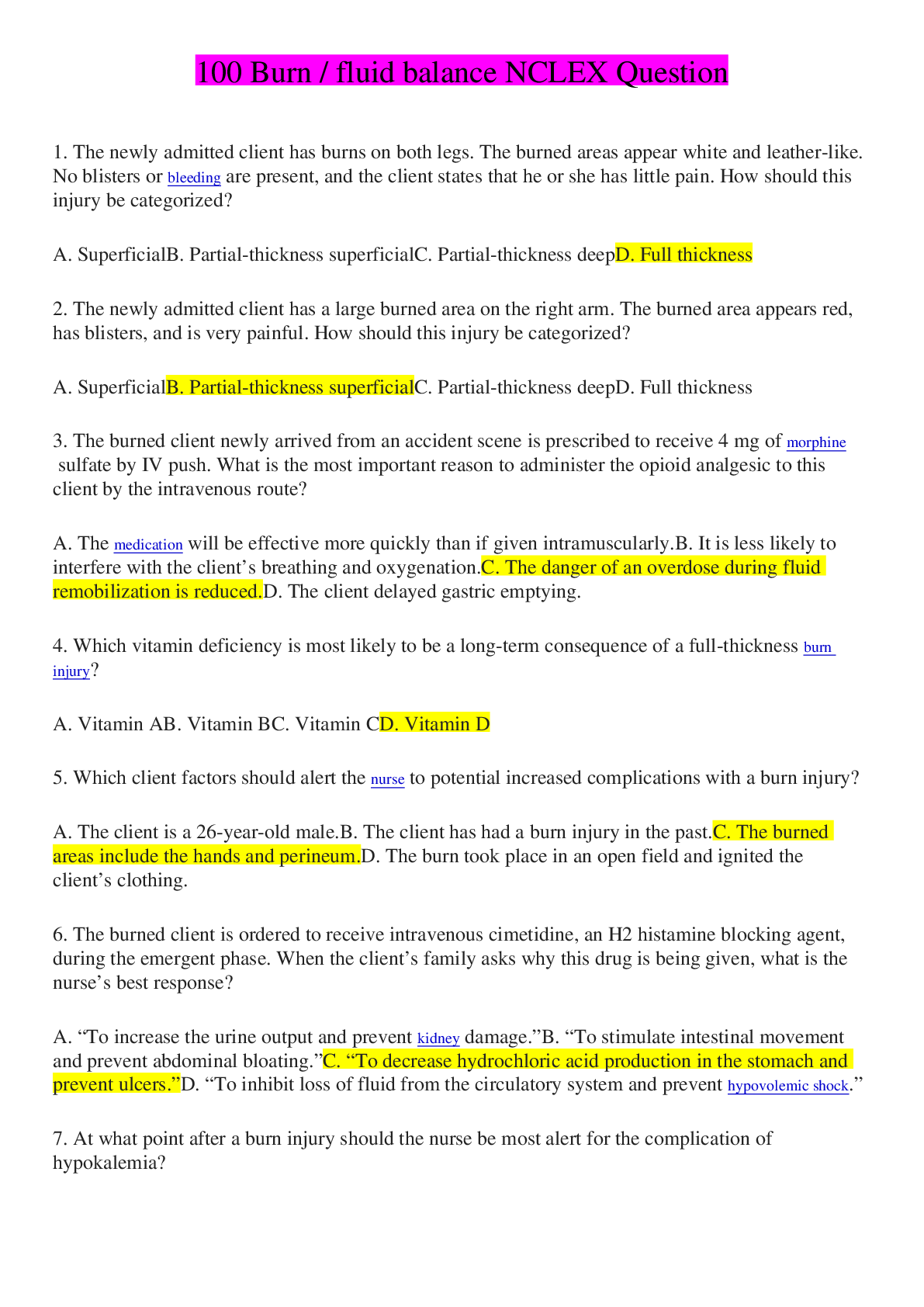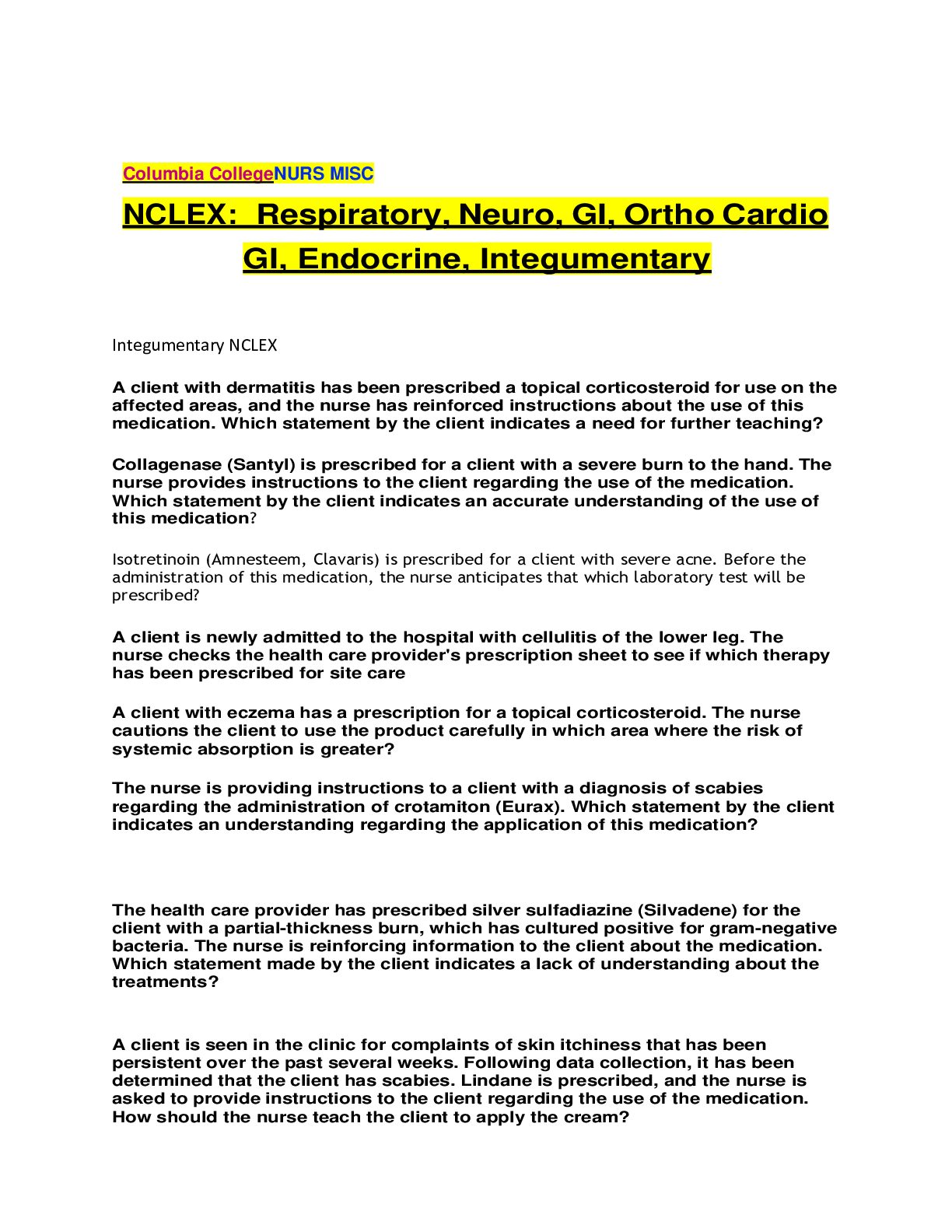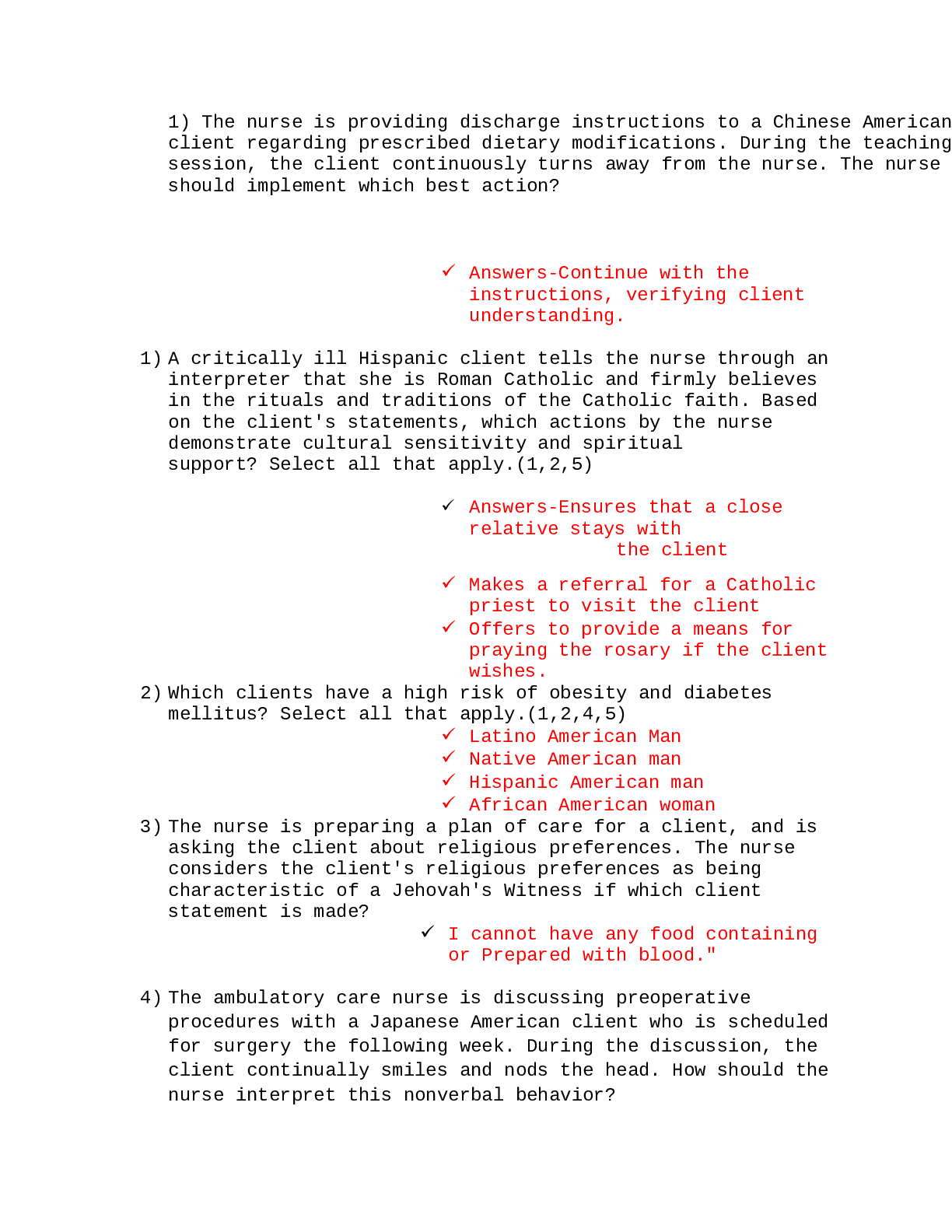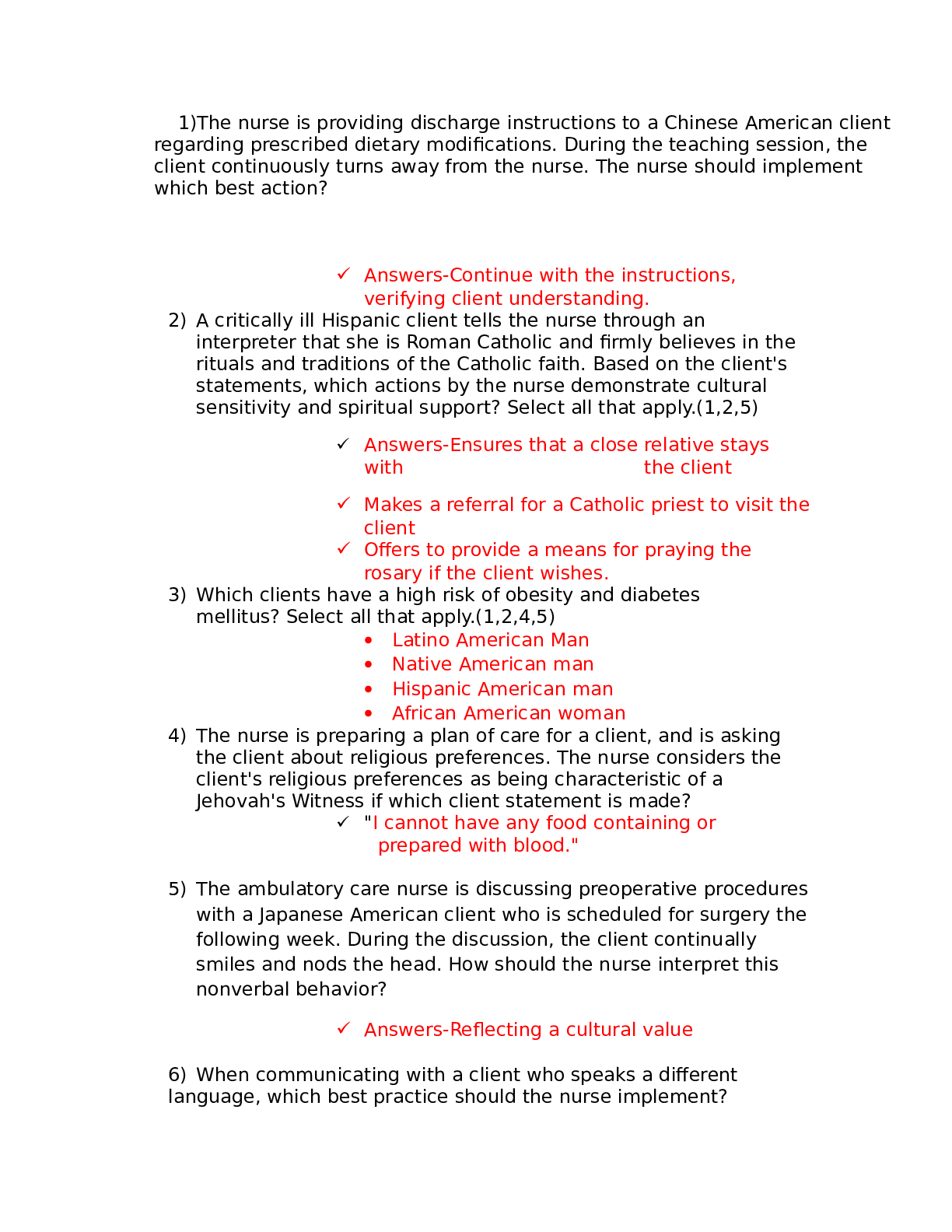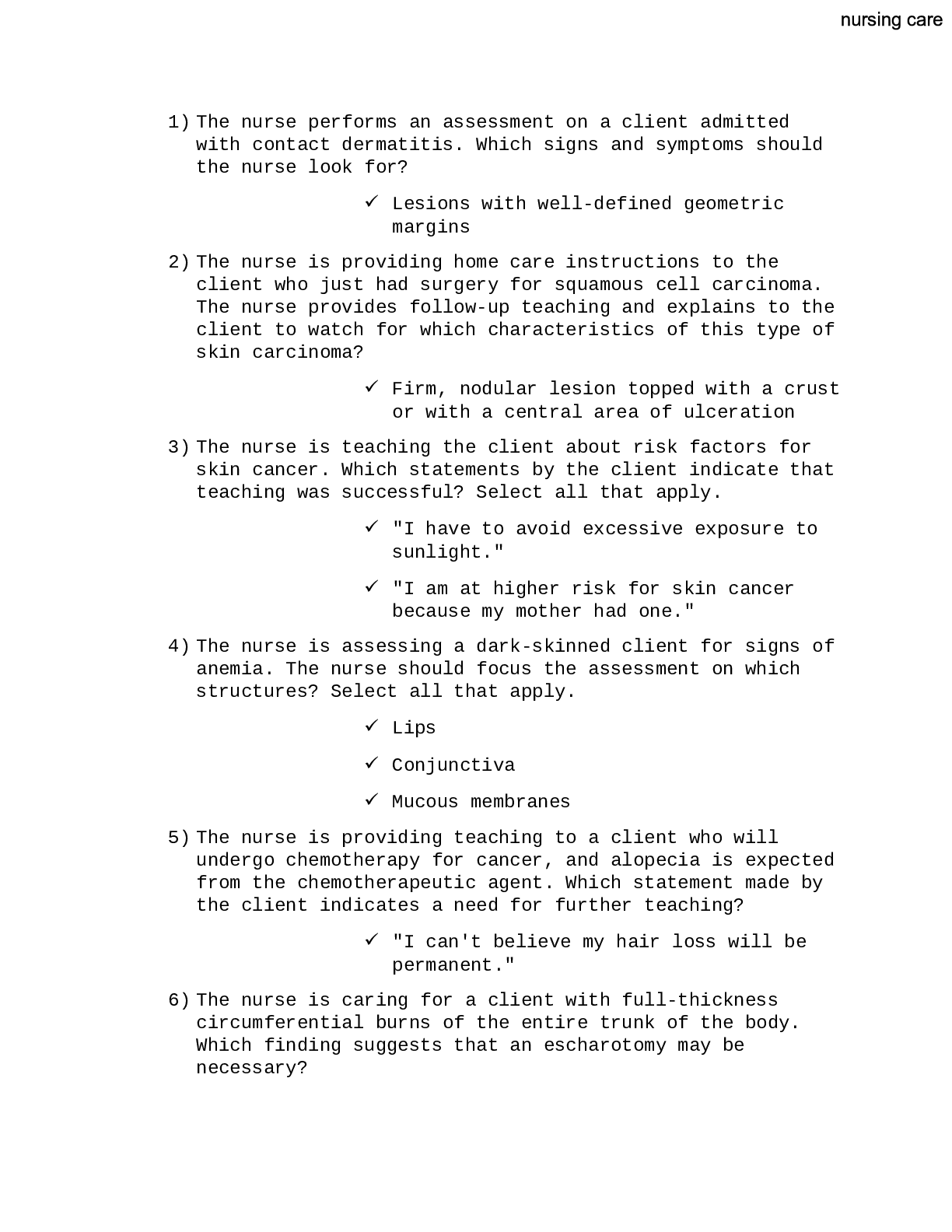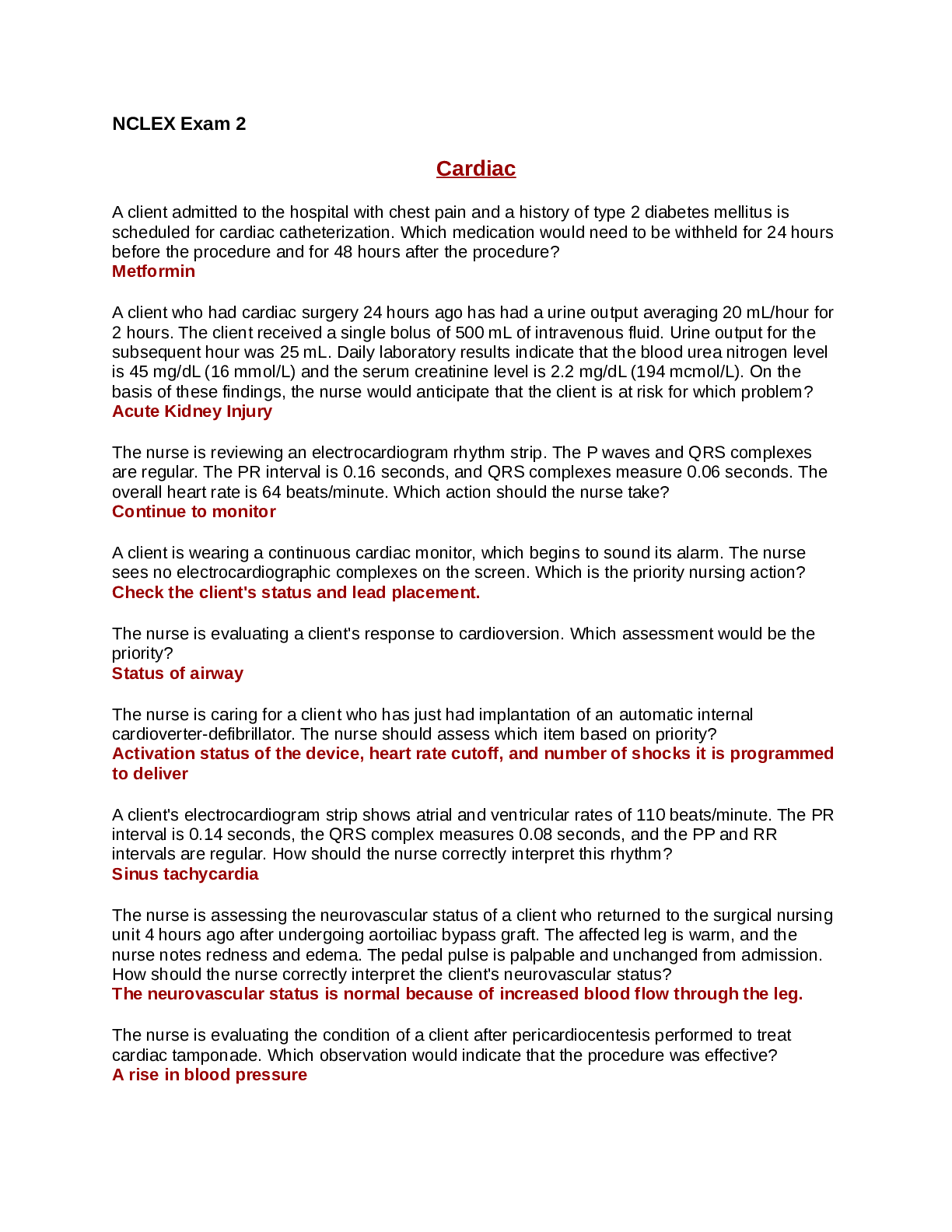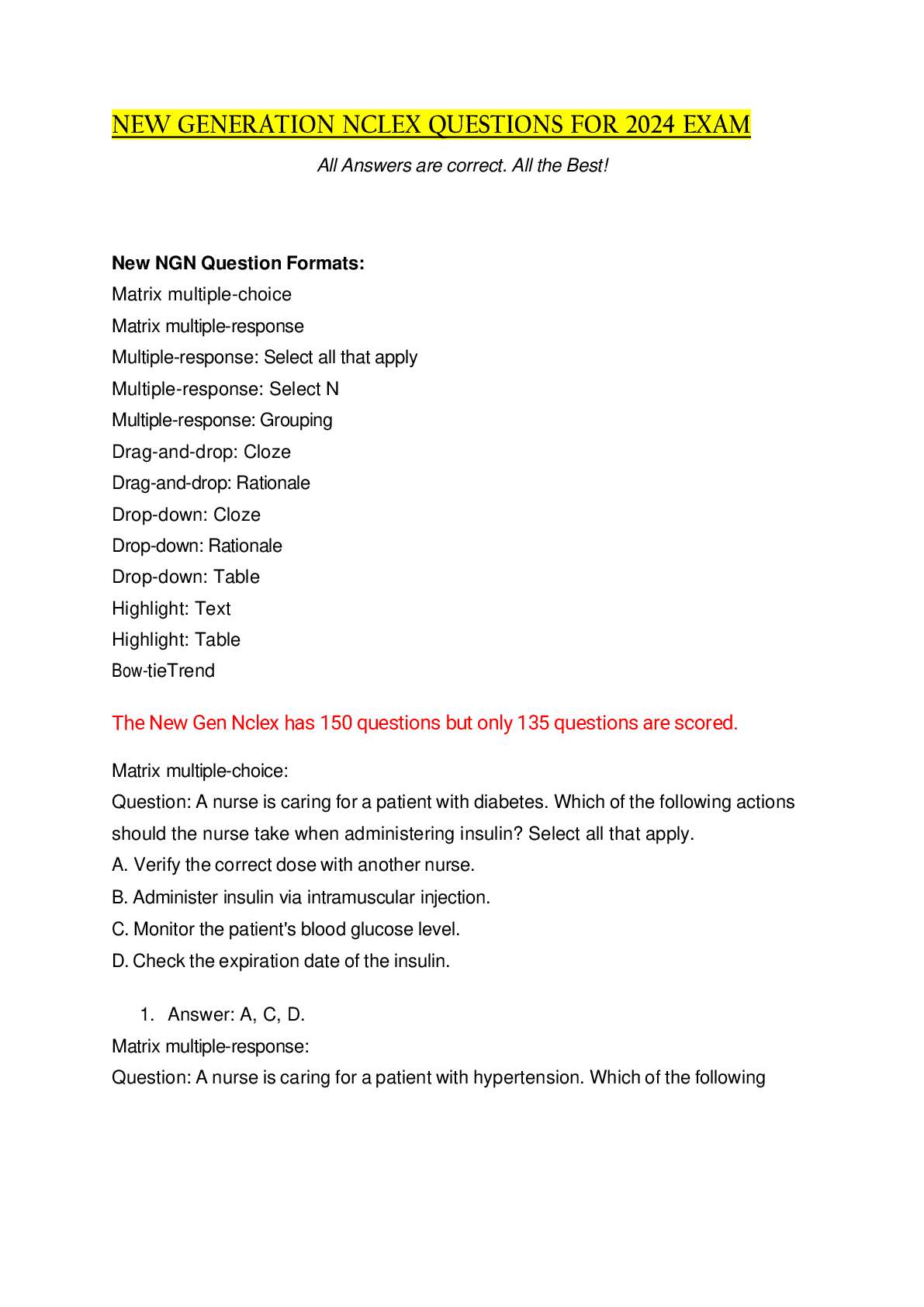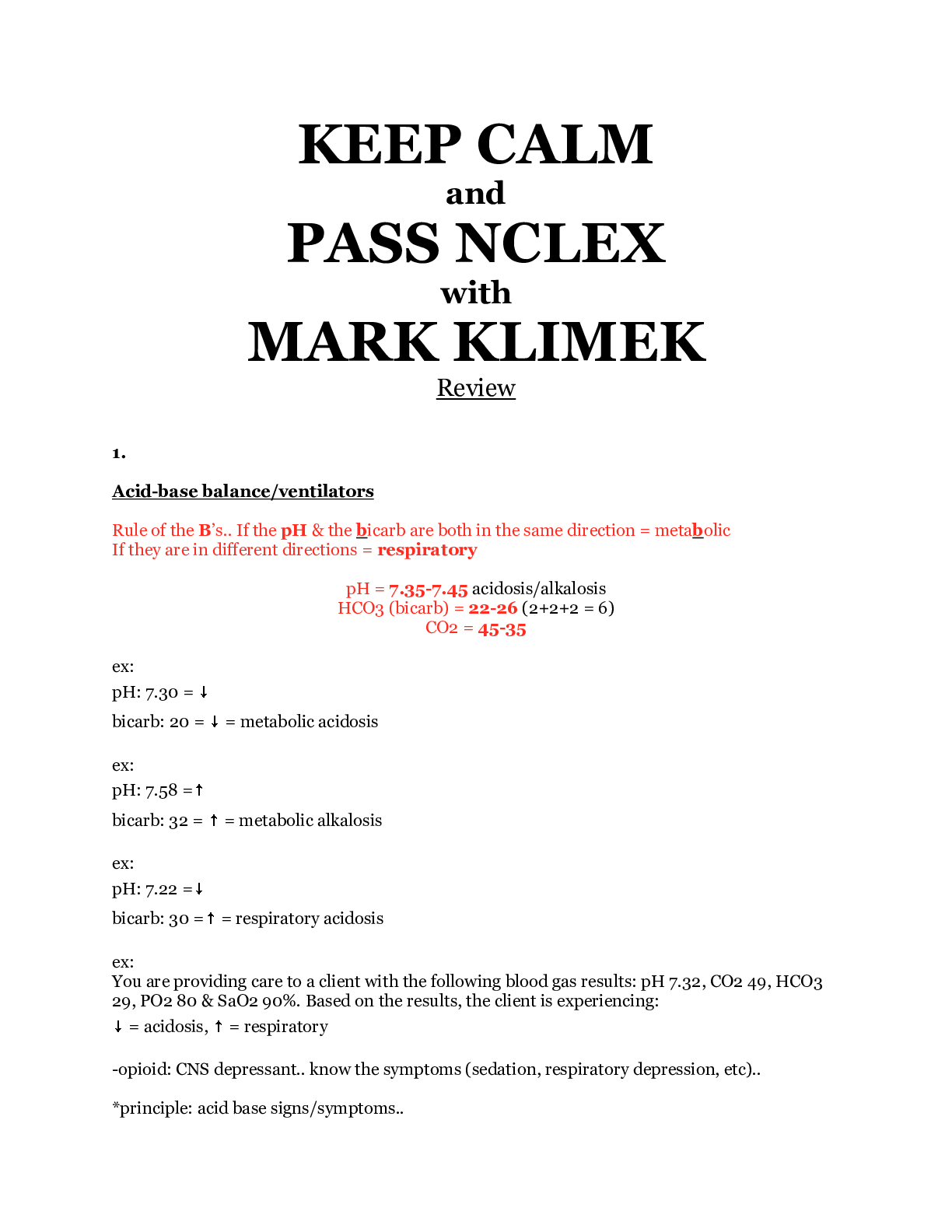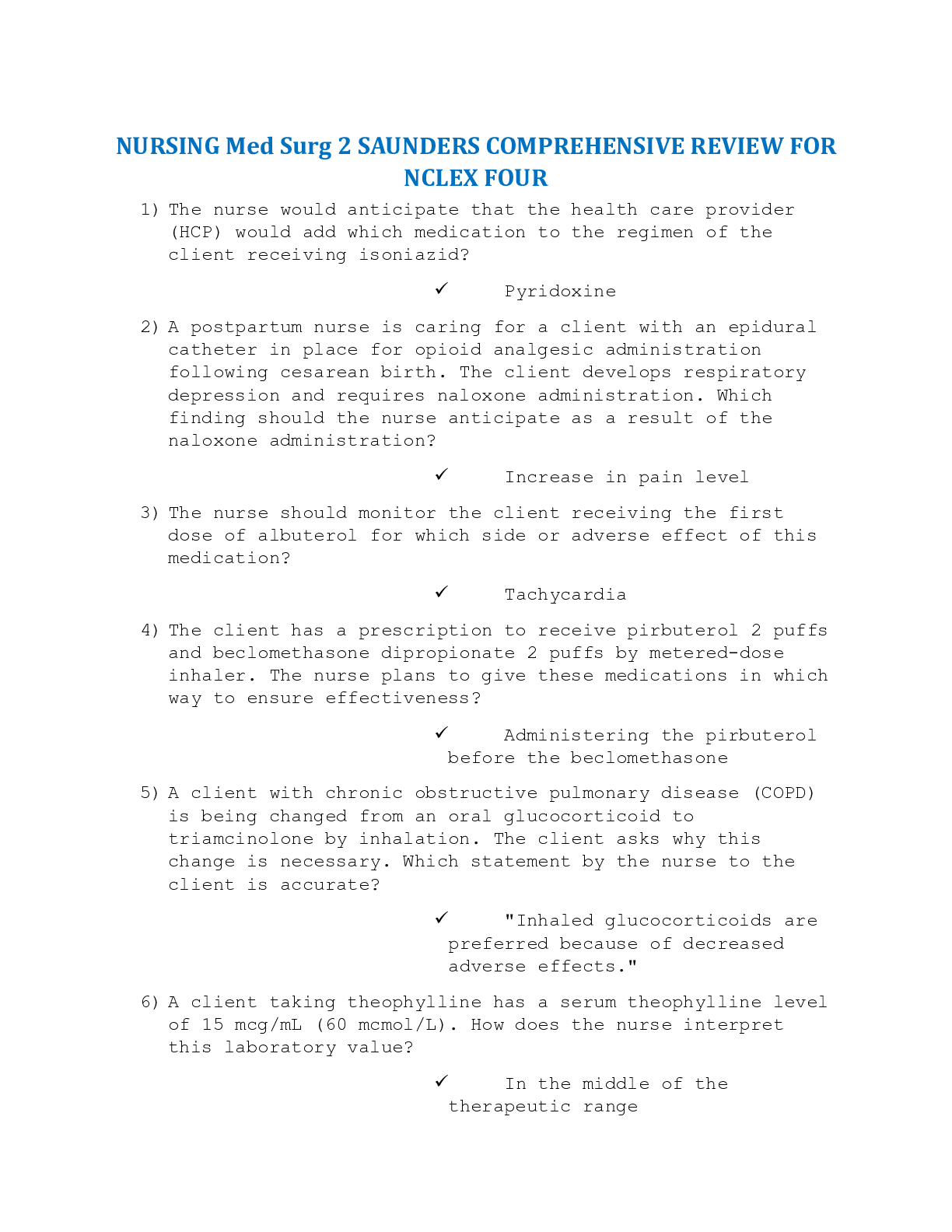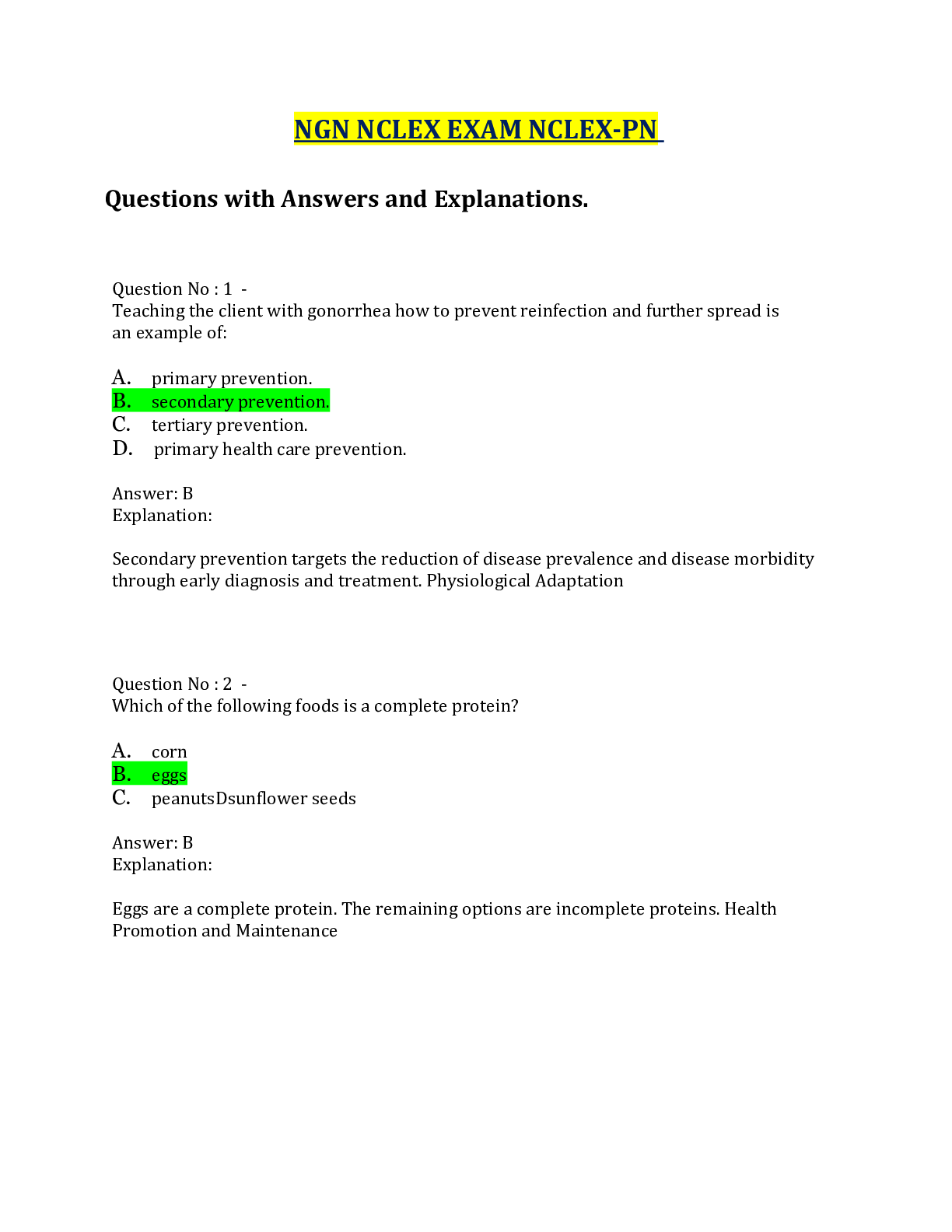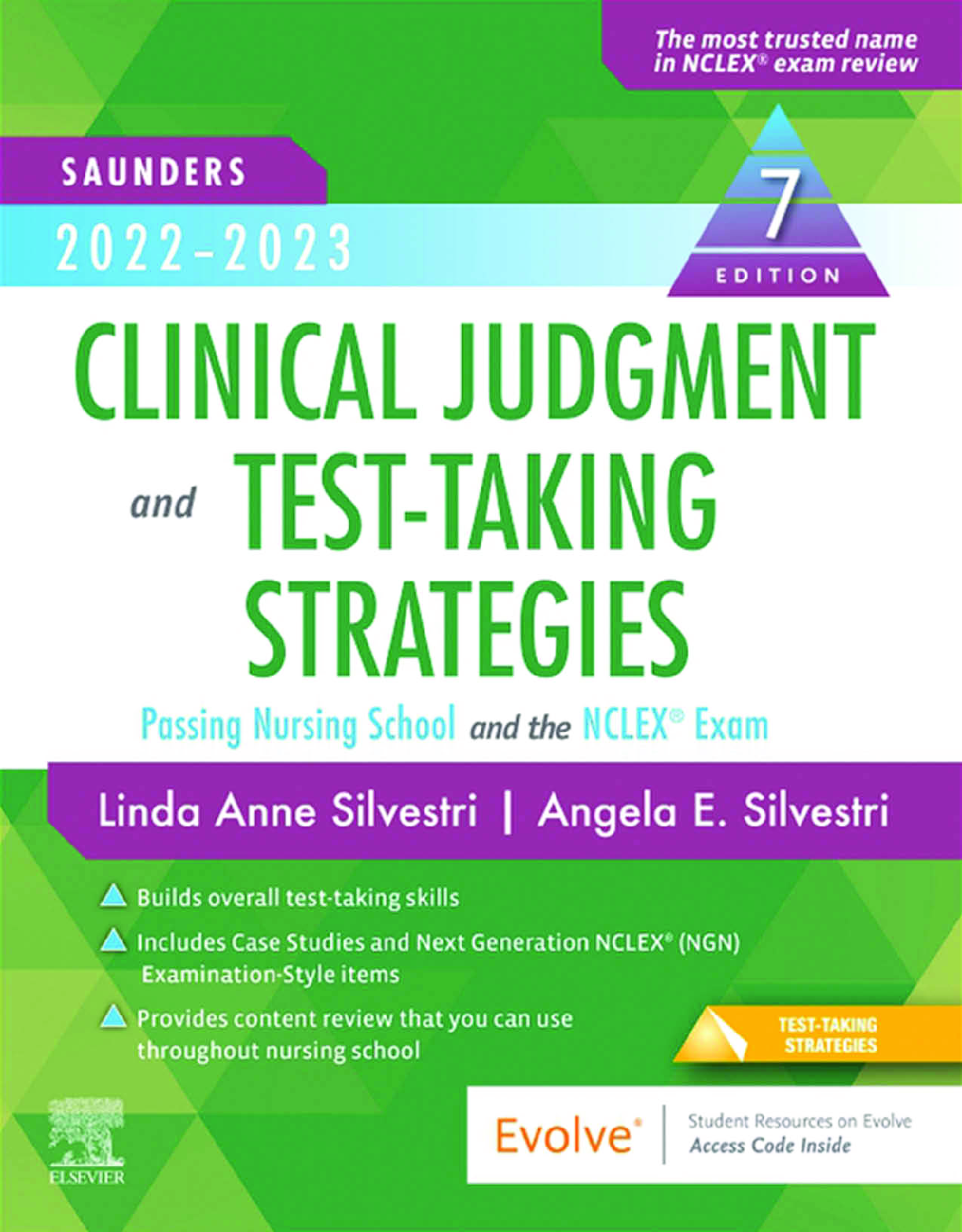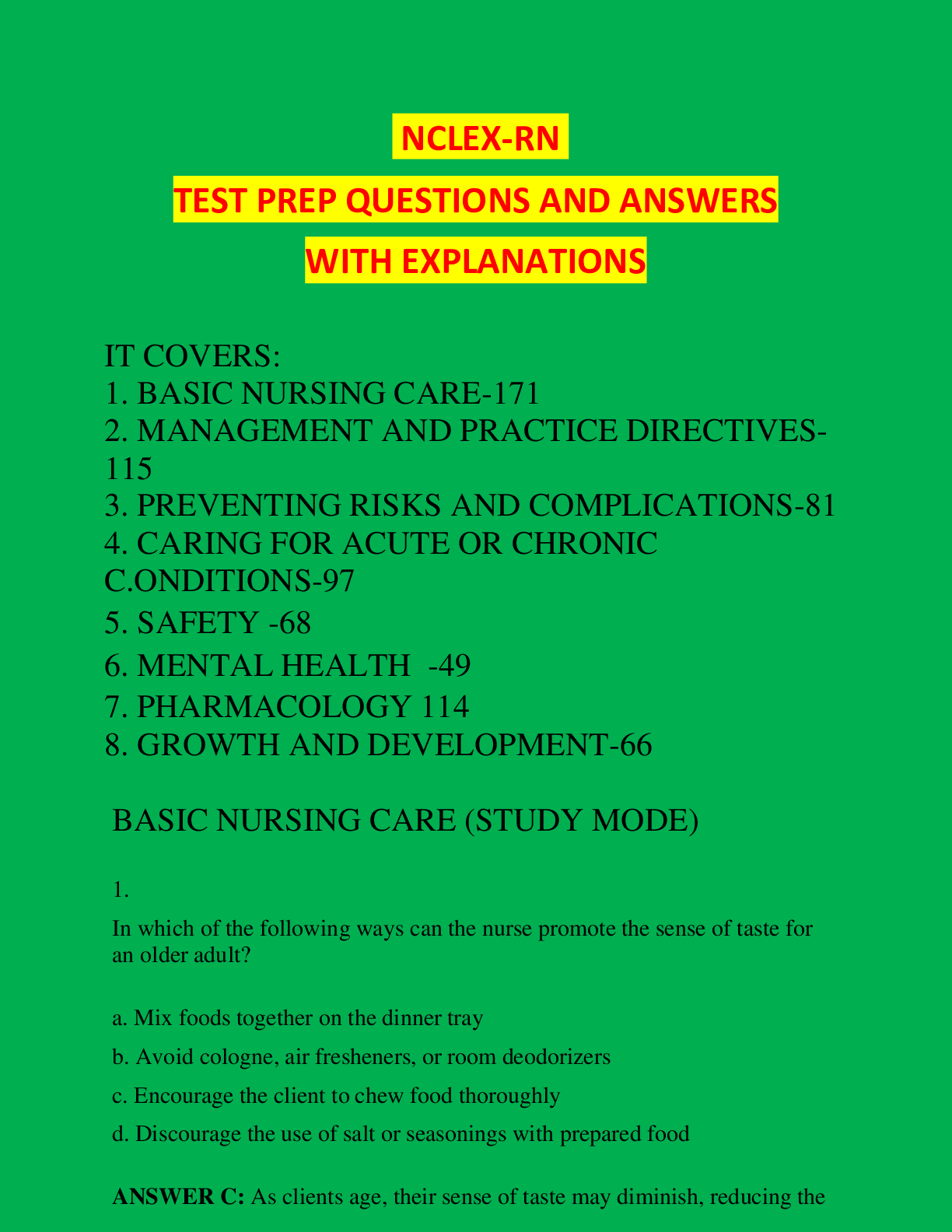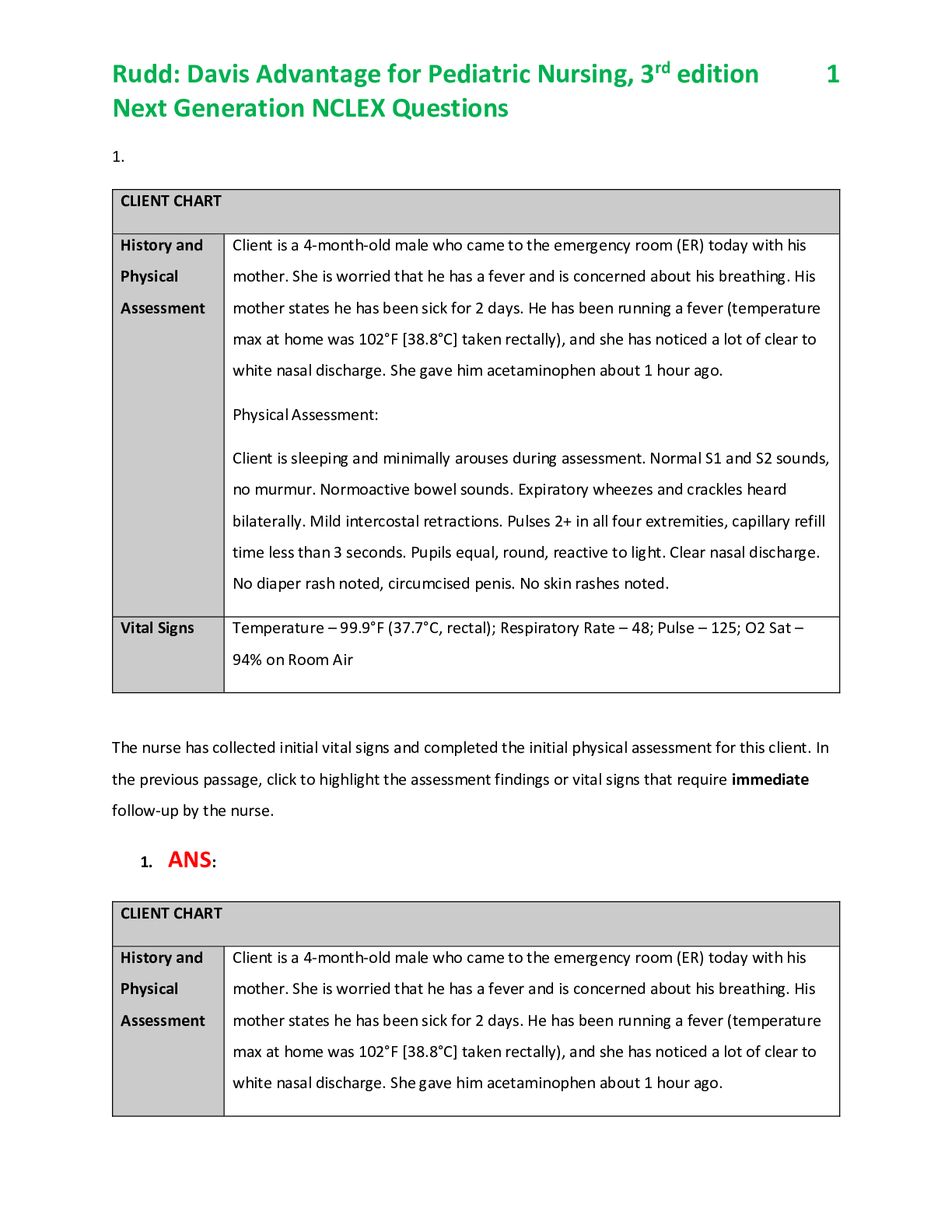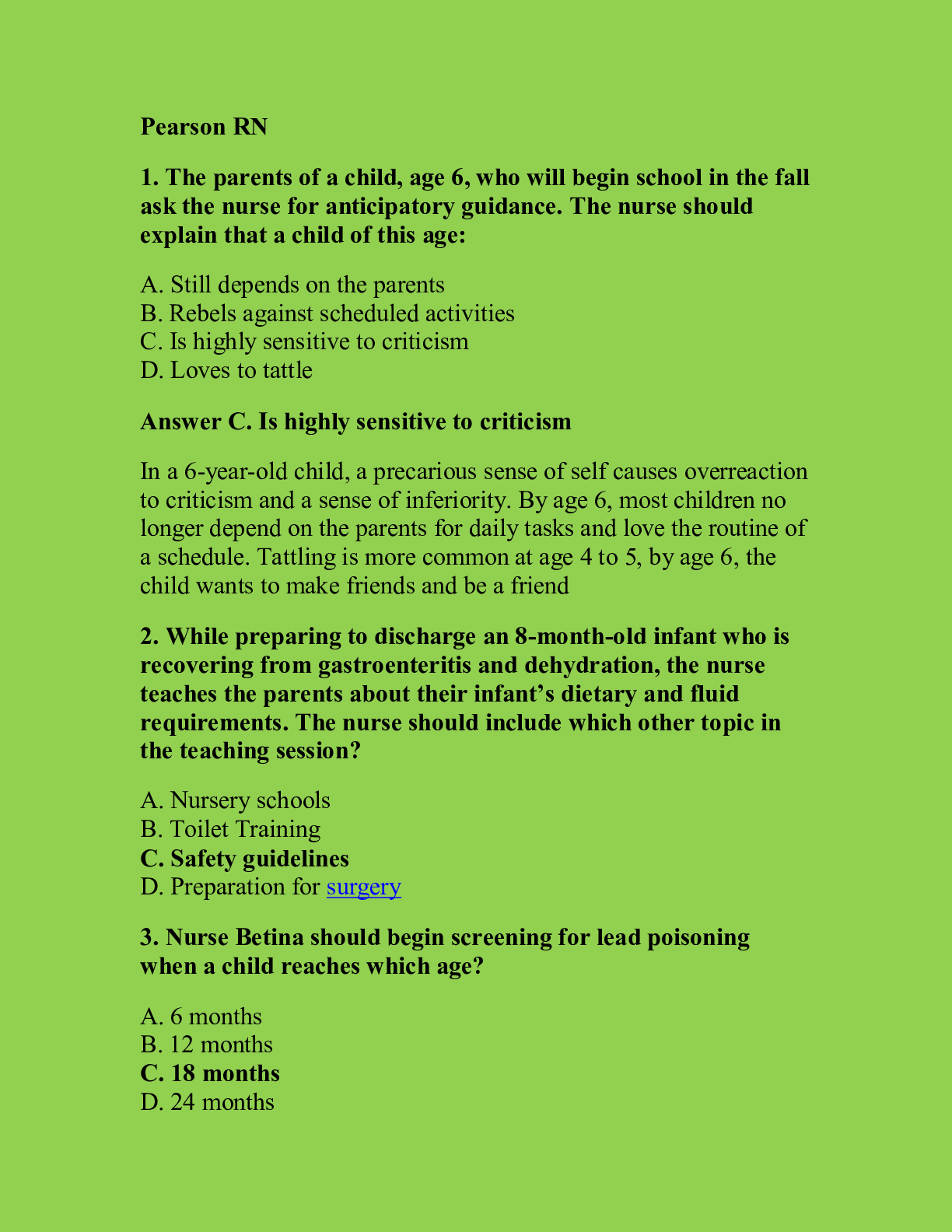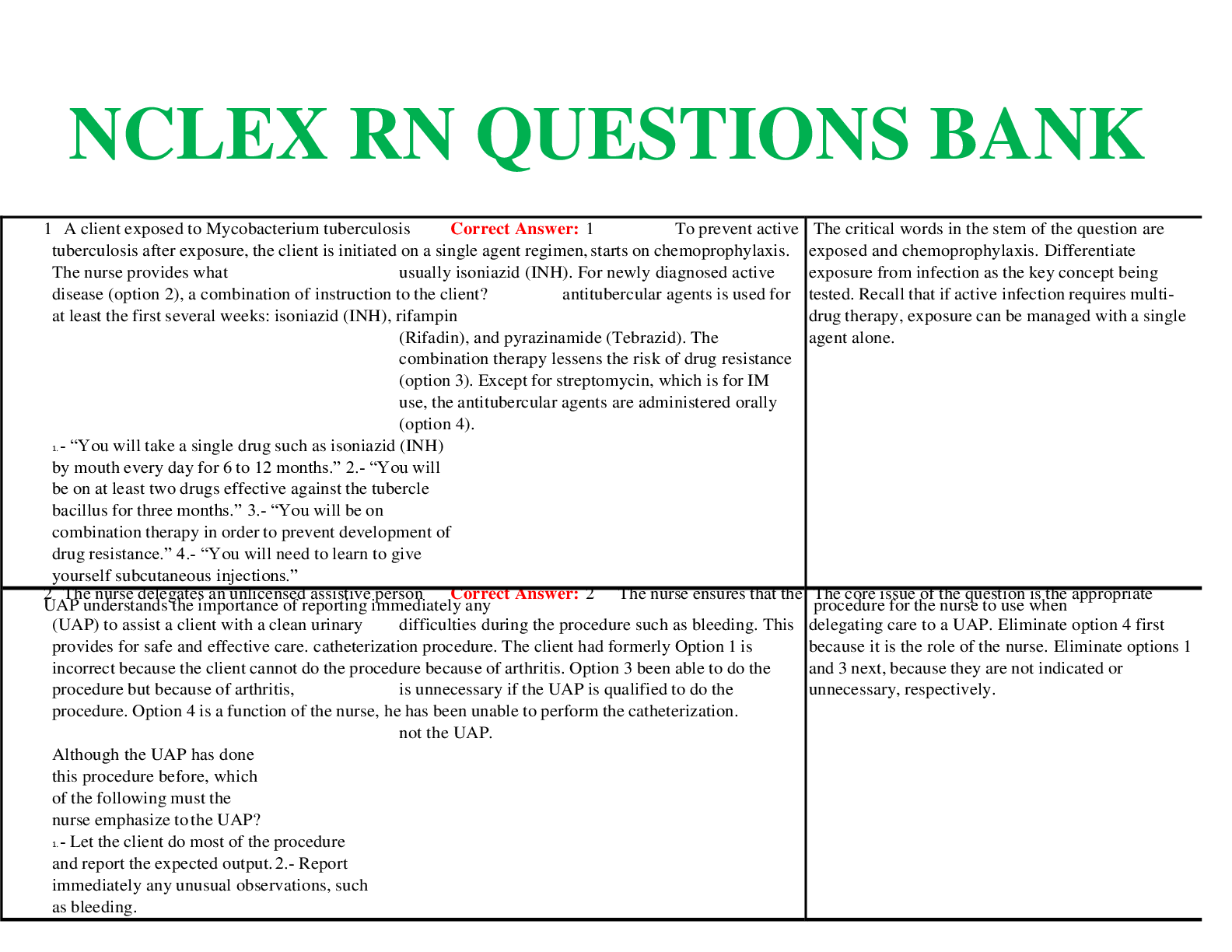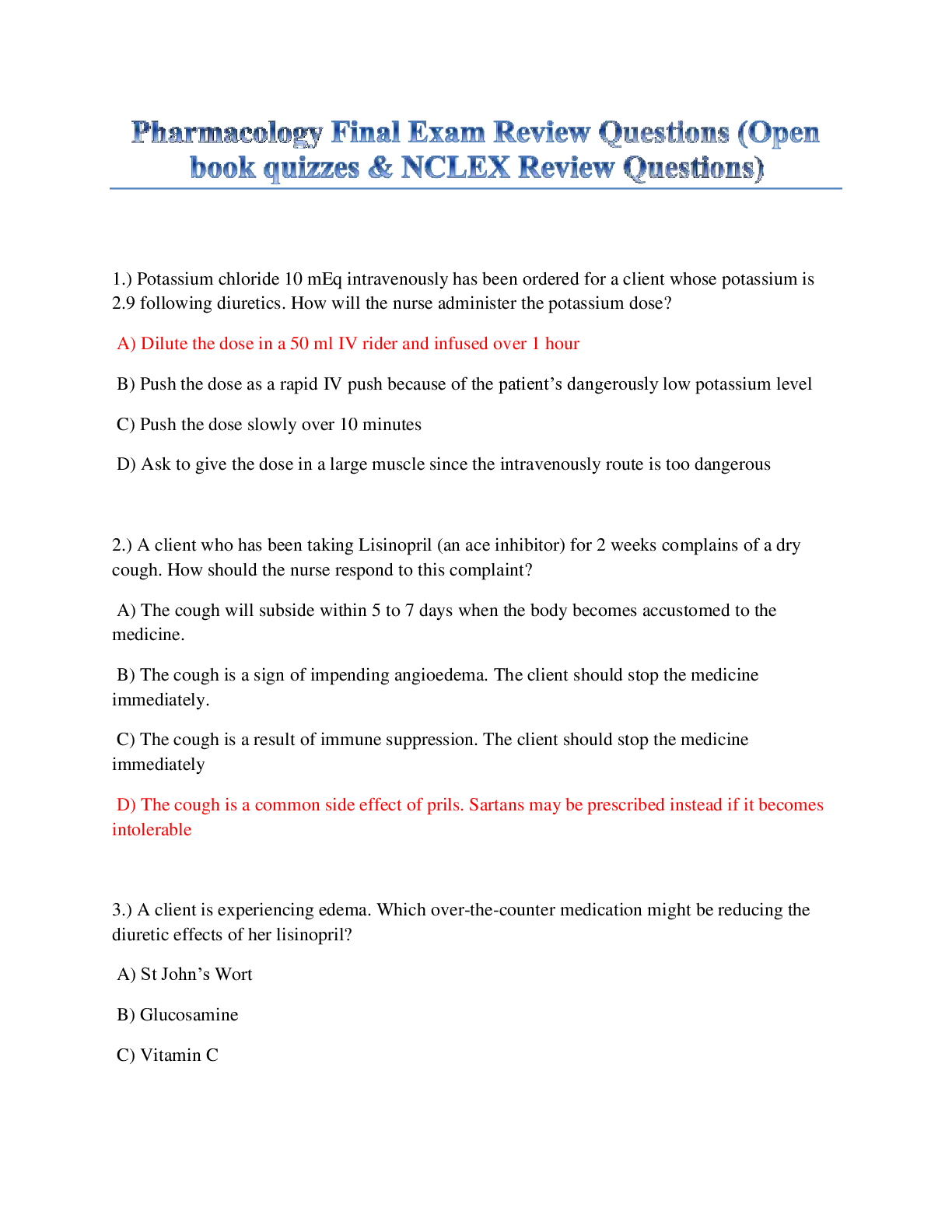passpoint review nclex
Document Content and Description Below
Question 1 See full question What is the nurse’s most important intervention for a client having a tonic-clonic seizure? You Selected: ⦁ Protect the client from further injury Correct res... ponse: ⦁ Protect the client from further injury Explanation: The priority during and after a seizure is to protect the person from injury by keeping them from falling to the floor. Furniture or other objects that be a source of injury during the seizure should be moved out of the client’s way. Timing the seizure, and noting the origin of the seizure are important, but are not the priority. Nothing should be placed in the client’s mouth during a seizure because teeth may be dislodged or the tongue pushed back, further obstructing the airway. Remediation: ⦁ Seizure management Question 2 See full question The nurse is caring for a neonate weighing 4,536 g (10 lb) who was born via cesarean section 1 hour ago to a mother with insulin-dependent diabetes. She asks the nurse, “Why is my baby in the neonatal intensive care unit?” The nurse bases a response on the understanding that neonates of mothers with diabetes commonly develop which condition? You Selected: ⦁ hypoglycemia Correct response: ⦁ hypoglycemia Explanation: Hypoglycemia is caused by the rapid depletion of glucose stores. In addition, neonates born to class women with insulin dependent diabetes are about seven times more likely to suffer from respiratory distress syndrome than neonates born to nondiabetic women. This neonate should be closely monitored for symptoms of hypoglycemia and respiratory distress. Neonates of diabetic mothers commonly have polycythemia, not anemia. Anemia and hemolytic disease are associated with erythroblastosis fetalis. Persistent pulmonary hypertension is associated with meconium aspiration syndrome. Remediation: ⦁ Glucose management, neonatal Question 3 See full question After knee replacement surgery, a client is being discharged with acetaminophen with codeine 30 mg tablets for pain. During discharge preparation, the nurse should include which instruction? You Selected: ⦁ "Avoid driving a car while taking this medication." Correct response: ⦁ "Avoid driving a car while taking this medication." Explanation: Clients taking codeine should avoid driving because the medication can impair mental alertness. Fluid restriction isn't indicated, especially after surgery. To prevent adverse GI effects such as nausea, vomiting, anorexia, and constipation, the client shouldn't take codeine on an empty stomach. Codeine may cause dizziness, drowsiness, and seizures but doesn't cause fine motor tremors. Remediation: ⦁ Codeine phosphate–acetaminophen Question 4 See full question The nurse manager has noticed a sharp increase in medication errors associated with IV antibiotic administration over the past 2 months. The nurse manager should discuss the situation with each nurse involved and then: You Selected: ⦁ ask them to attend in-service training for administration of IV medications. Correct response: ⦁ ask them to attend in-service training for administration of IV medications. Explanation: Identification of causes of medication errors requires in-service education to inform the staff of strategies to decrease these errors. Errors are frequently the result of systemic problems that can be identified and rectified through problem-solving techniques and changes in procedures. Documenting or reporting the situation would not directly assist the nurses in eliminating errors. Reporting the incidents to the hospital attorney is unnecessary. Remediation: ⦁ Safe medication administration practices Question 5 See full question Clients receiving a monoamine oxidase inhibitor must avoid tyramine, a compound found in which foods? You Selected: ⦁ Aged cheese and Chianti wine Correct response: ⦁ Aged cheese and Chianti wine Explanation: Aged cheese and Chianti wine contain high concentrations of tyramine. Green, leafy or yellow vegetables, figs, cream cheese, and fruit are low in tyramine. Remediation: ⦁ Tranylcypromine Question 6 See full question A client with a diagnosis of schizophrenia and who is paranoid asks the nurse, "How do I know what is really in those pills?" The best response is to: You Selected: ⦁ allow the client to open the individual medication wrappers. Correct response: ⦁ allow the client to open the individual medication wrappers. Explanation: Allowing a paranoid client to open his medication can help reduce his suspiciousness. Telling the client that he should know the pills are his medicine is incorrect because the client doesn't know this information for sure; he's obviously suspicious that it isn't. Telling the client not to worry or ignoring his comment isn't supportive and doesn't reassure him. Remediation: ⦁ Oral drug administration, psychiatric patient Question 7 See full question When instilling erythromycin ointment into the eyes of a neonate 1 hour old, the nurse would explain to the parents that the medication is used to prevent which problem? You Selected: ⦁ cataracts from beta-hemolytic streptococcus Correct response: ⦁ blindness secondary to gonorrhea Explanation: The instillation of erythromycin into the neonate’s eyes provides prophylaxis for ophthalmia neonatorum, or neonatal blindness caused by gonorrhea in the mother. Erythromycin is also effective in the prevention of infection and conjunctivitis from Chlamydia trachomatis. The medication may result in redness of the neonate’s eyes, but this redness will eventually disappear. Erythromycin ointment is not effective in treating neonatal chorioretinitis from cytomegalovirus. No effective treatment is available for a mother with cytomegalovirus. Erythromycin ointment is not effective in preventing cataracts. Additionally, neonatal infection with beta-hemolytic streptococcus results in pneumonia, bacterial meningitis, or death. Cataracts in the neonate may be congenital or may result from maternal exposure to rubella. Erythromycin ointment is also not effective for preventing and treating strabismus (crossed eyes). Infants may exhibit intermittent strabismus until 6 months of age. Remediation: ⦁ Neonatal eye prophylaxis Question 8 See full question For the client who has difficulty falling asleep at night because of withdrawal symptoms from alcohol, which are abating, which nursing intervention is likely to be most effective? You Selected: ⦁ teaching the client relaxation exercises to use before bedtime Correct response: ⦁ teaching the client relaxation exercises to use before bedtime Explanation: The best action by the nurse to help a client who has difficulty falling asleep would be to teach the client relaxation exercises to use before bedtime to reduce anxiety and promote relaxation. This activity will also be useful for the client when out of the hospital. Inviting the client to play a board game is inappropriate because this activity can be competitive and thus stimulate the client. Allowing the client to sit in the community room until she feels sleepy is inappropriate because it does nothing to help the client relax. Taking frequent naps can worsen the ability to fall asleep at night. Remediation: ⦁ Relaxation and stress management techniques ⦁ Alcoholism Question 9 See full question An 18-year-old is highly dependent on her parents and fears leaving home to attend college. Shortly before the fall semester starts, she complains that her legs are paralyzed and is rushed to the emergency department. When physical examination rules out a physical cause for her paralysis, the physician admits the woman to the psychiatric unit, where she is diagnosed with functional neurologic symptom disorder. She asks the nurse, "Why has this happened to me?" What is the nurse's best response? You Selected: ⦁ "Your problem is real but, there is no physical basis for it. We'll work on what is going on in your life to find out why it's happened." Correct response: ⦁ "Your problem is real but, there is no physical basis for it. We'll work on what is going on in your life to find out why it's happened." Explanation: The nurse must be honest by telling the client that her paralysis has no physiologic cause while also conveying empathy and acknowledging that her symptoms are real. The client will benefit from psychiatric treatment, which will help her understand the underlying cause of her symptoms. After her psychological conflict is resolved, her symptoms will disappear. Telling the client that being unable to move her legs must be awful wouldn't answer the client's question; knowing that the cause is psychological rather than physical wouldn't necessarily make her feel better. Telling the client that she has developed paralysis to avoid leaving her parents or that her personality caused her disorder wouldn't help her understand and resolve the underlying conflict. Remediation: ⦁ Conversion disorder patient care ⦁ Psychiatric nursing assessment Question 10 See full question A client periodically has acute panic attacks. These attacks are unpredictable and have no apparent association with a specific object or situation. During an acute panic attack, the client may experience: You Selected: ⦁ a decreased perceptual field. Correct response: ⦁ a decreased perceptual field. Explanation: Panic is the most severe level of anxiety. During a panic attack, a client's perceptual field, narrows. He becomes more focused on himself, less aware of surroundings, and unable to process information from his environment. His decreased perceptual field impairs his attention and ability to concentrate. During an acute panic attack, the client may experience an increase, not a decrease, in heart and respiratory rates, resulting from stimulation of the sympathetic nervous system. Remediation: ⦁ Panic disorder Question 11 See full question A nurse obtained a client’s fasting blood sugar (FBS) at 0700, which was 144 mg/dL (8 mmol/L). The client has an order for regular insulin 8 units every morning. What should the nurse do next? You Selected: ⦁ Administer the insulin as ordered. Correct response: ⦁ Administer the insulin as ordered. Explanation: The nurse should know that a normal fasting blood sugar is between 72 and 108 mg/dL (4 and 6 mmol/L). The result of 144 mg/dL indicates that the client requires insulin to lower the blood glucose level. The other options are incorrect because they do not reflect the nurse's understanding of diabetes and its treatment. Remediation: ⦁ Blood glucose monitoring ⦁ Insulins (short-acting) ⦁ Hormonal Control of Blood Glucose Question 12 See full question A nurse is providing discharge teaching to a client who is immunosuppressed. Which statement by the client indicates the need for additional teaching? You Selected: ⦁ "I can eat whatever I want as long as it's low in fat." Correct response: ⦁ "I can eat whatever I want as long as it's low in fat." Explanation: The client requires additional teaching if he states that he can eat whatever he wants. Immunosuppressed clients should avoid raw fruit and vegetables because they may contain bacteria that could increase the risk of infection; foods must be thoroughly cooked. Avoiding people who are sick, products containing alcohol, and people who have just received vaccines are appropriate actions for an immunosuppressed client. Remediation: ⦁ Neutropenia Question 13 See full question The client with acute renal failure is recovering and asks the nurse, "Will my kidneys ever function normally again?" The nurse's response is based on knowledge that the client's renal status will most likely: You Selected: ⦁ continue to improve over a period of weeks. Correct response: ⦁ continue to improve over a period of weeks. Explanation: The kidneys have a remarkable ability to recover from serious insult. Recovery may take 3 to 12 months. The client should be taught how to recognize the signs and symptoms of decreasing renal function and to notify the health care provider (HCP) if such problems occur. In a client who is recovering from acute renal failure, there is no need for renal transplantation or permanent hemodialysis. Chronic renal failure develops before end-stage renal failure. Remediation: ⦁ Renal failure, acute ⦁ Urinary: Renal Function Question 14 See full question Which is the most important initial postprocedure nursing assessment for a client who has had a cardiac catheterization? You Selected: ⦁ Observe the puncture site for swelling and bleeding. Correct response: ⦁ Observe the puncture site for swelling and bleeding. Explanation: Assessment of circulatory status, including observation of the puncture site, is of primary importance after a cardiac catheterization. Laboratory values and skin warmth and turgor are important to monitor but are not the most important initial nursing assessment. Neurologic assessment every 15 minutes is not required. Remediation: ⦁ Cardiac catheterization Question 15 See full question The nurse is administering packed red blood cells (PRBCs) to a client. The nurse should first: You Selected: ⦁ stay with the client during the first 15 minutes of infusion. Correct response: ⦁ stay with the client during the first 15 minutes of infusion. Explanation: The most likely time for a blood transfusion reaction to occur is during the first 15 minutes or first 50 ml of the infusion. If a blood transfusion reaction does occur, it is imperative to keep an established I.V. line so that medication can be administered to prevent or treat cardiovascular collapse in case of anaphylaxis. PRBCs should be administered through a 19-gauge or larger needle; a peripherally inserted central catheter line is not recommended, in order to avoid a slow flow. RBCs will hemolyze in dextrose or lactated Ringer's solution and should be infused with only normal saline solution. Remediation: ⦁ Blood product transfusion management ⦁ Blood product transfusion Question 16 See full question A nurse is performing a sterile dressing change. Which action contaminates the sterile field? You Selected: ⦁ Pouring solution onto a sterile field cloth Correct response: ⦁ Pouring solution onto a sterile field cloth Explanation: Pouring solution onto a sterile field cloth contaminates the sterile field because moisture penetrating the cloth can carry microorganisms to the sterile field via capillary action. Holding sterile objects above the waist, leaving a 1″ edge around the sterile field, and opening the outermost flap of a sterile package away from the body maintain the sterile field. Remediation: ⦁ Sterile field management, OR ⦁ Cleaning a Wound and Applying a Sterile Dressing Question 17 See full question The nurse administers a tap water enema to a client. While the solution is being infused, the client has abdominal cramping. What should the nurse do first? You Selected: ⦁ Temporarily stop the infusion, and have the client take deep breaths. Correct response: ⦁ Temporarily stop the infusion, and have the client take deep breaths. Explanation: If the client begins to experience abdominal cramping during administration of the enema fluid, the nurse’s first action is to temporarily stop the infusion and have the client take a few deep breaths. After the cramping subsides, the nurse can continue with the enema solution. If the cramping does not subside, the nurse should clamp the tubing and remove it. Raising the height of the container will increase the flow of fluid and cause the cramping to increase. Rubbing the abdomen while infusing the enema fluid will not stop the cramping. Remediation: ⦁ Enema administration Question 18 See full question The nurse is admitting a hospital client who does not speak English and who is accompanied by the client's school-aged child. The client appears to be in pain, but the nurse is unable to assess the character or history of the client's pain. How should the nurse best communicate with the client? You Selected: ⦁ Ask the client's child to describe the client's pain to the best of the client's ability. Correct response: ⦁ Enlist the help of a hospital interpreter; ask the son to translate if none is readily available. Explanation: Whenever possible, interpreters should be used to communicate with clients who do not speak English. If none is available, however, it may be necessary to have a family member translate. It would be unsafe to put off an emergency assessment pending the arrival of an interpreter. Remediation: [Show More]
Last updated: 1 year ago
Preview 1 out of 107 pages
.png)
Reviews( 0 )
Document information
Connected school, study & course
About the document
Uploaded On
Mar 23, 2021
Number of pages
107
Written in
Additional information
This document has been written for:
Uploaded
Mar 23, 2021
Downloads
0
Views
48


.png)
.png)
